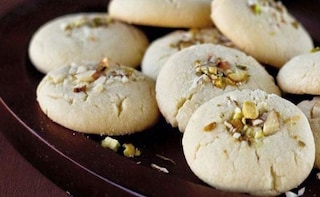Image Credits: Instagram/mellownspicy
Bhicoo Manekshaw's NankhataiIngredients:
5 cups maida
A pinch of salt
1 tsp crushed green cardamom seeds
2 tsp soda bicarbonate
2 ½ cups castor sugar
50 gm ghee or butter
6-8 Tbsp curd, beaten till smooth
Cashew nut halves, for decoration (or almond or pistachio or chironji)Method:
1. Set oven to 175 degrees C (or 350 degrees F).
2. Sift flour with salt, crushed cardamom and bicarb of soda.
3. Beat ghee or butter with sugar till light and fluffy. Add curd and mix well. Add flour and mix to a stiff dough. Rest dough for half an hour.
4. Place one teaspoon mixture on a greased baking tray for each biscuit, leaving a space of 2 inches between each. Place a cashew nut on top of each biscuit.
5. Place in oven and bake for about 20-25 minutes.
2. The khatais may take less than 20 minutes to bake; mine were done in about 15.
3. After baking, make sure to let the biscuits stand on a wire rack or sheet to cool - they will harden into the perfect nankhatai texture.
4. Oh and don't skimp on the butter (or ghee). Its speciality is its decadence.About the author: Meher Mirza is an independent writer and editor, with a focus on food and travel. Formerly with BBC Good Food India, she loves anime, animals and artsy things but also comics, technology and death metal.Disclaimer: The opinions expressed within this article are the personal opinions of the author. NDTV is not responsible for the accuracy, completeness, suitability, or validity of any information on this article. All information is provided on an as-is basis. The information, facts or opinions appearing in the article do not reflect the views of NDTV and NDTV does not assume any responsibility or liability for the same.
Advertisement
Advertisement
Bhicoo Manekshaw's NankhataiIngredients:
5 cups maida
A pinch of salt
1 tsp crushed green cardamom seeds
2 tsp soda bicarbonate
2 ½ cups castor sugar
50 gm ghee or butter
6-8 Tbsp curd, beaten till smooth
Cashew nut halves, for decoration (or almond or pistachio or chironji)Method:
1. Set oven to 175 degrees C (or 350 degrees F).
2. Sift flour with salt, crushed cardamom and bicarb of soda.
3. Beat ghee or butter with sugar till light and fluffy. Add curd and mix well. Add flour and mix to a stiff dough. Rest dough for half an hour.
4. Place one teaspoon mixture on a greased baking tray for each biscuit, leaving a space of 2 inches between each. Place a cashew nut on top of each biscuit.
5. Place in oven and bake for about 20-25 minutes.
Advertisement
Advertisement
2. The khatais may take less than 20 minutes to bake; mine were done in about 15.
3. After baking, make sure to let the biscuits stand on a wire rack or sheet to cool - they will harden into the perfect nankhatai texture.
4. Oh and don't skimp on the butter (or ghee). Its speciality is its decadence.About the author: Meher Mirza is an independent writer and editor, with a focus on food and travel. Formerly with BBC Good Food India, she loves anime, animals and artsy things but also comics, technology and death metal.Disclaimer: The opinions expressed within this article are the personal opinions of the author. NDTV is not responsible for the accuracy, completeness, suitability, or validity of any information on this article. All information is provided on an as-is basis. The information, facts or opinions appearing in the article do not reflect the views of NDTV and NDTV does not assume any responsibility or liability for the same.
For the latest food news, health tips and recipes, like us on Facebook or follow us on Twitter and YouTube.
Advertisement
